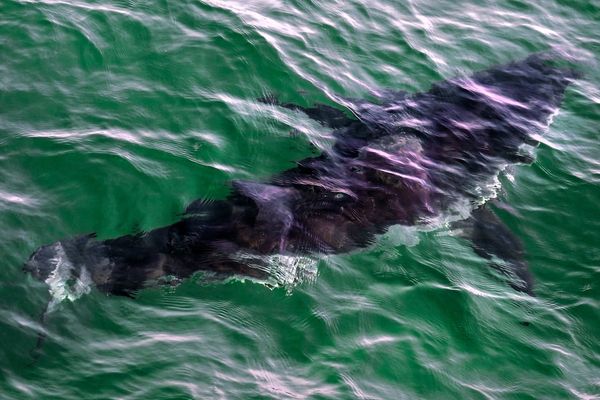With her two outstretched hands, five-year-old Olenka Stepowski energetically reaches and pulls herself up to a horizontal bar above a ladder and slings her legs in either direction.
Her grandmother Susan Jackson-Stepowski watches on with pleasure. This is exactly what was intended with this iconic old-school play equipment, she says.
"Their climbing frames were deliberately designed to increase physical ability in city children," Ms Jackson-Stepowski told ABC Radio Sydney.
As a heritage consultant, Ms Jackson-Stepowski knows a lot about this play equipment.
She says they not only were made to build up children, but that their origin was in a "major propaganda exercise".
Society 'mesmerised' by space
Few parents may realise that this innocent scene of children clambering over the poles, slides and ladders on the rocket ship is closely linked to the Cold War.
The Space Race between the United States and the Soviet Union inspired everything from fashion, furniture, commercials, and cartoons to be centred around space travel.
This also included play equipment.
Rocket play equipment started to be brought to Sydney in the mid-1950s, according to Ms Jackson-Stepowski.
"Society was just mesmerised by anything to do with space," she says.
At the height of their popularity, they could be found from Toowoomba right through to Elizabeth in South Australia.
The parks also popped up in the United States, the United Kingdom, and the Soviet Union all keen to get their kids interested in space.
"The Soviet Union also had their rockets as well for their cosmonauts," Ms Jackson-Stepowski says.
"So it was a major propaganda exercise between the two powers for the minds of children during that era."
A symbol of Australia's role
One of the best examples of these playground rockets can be found in Moree in northern New South Wales.
The rocket is a special symbol for Moree, which was home to the first Overseas Telecommunications Commission (OTC) satellite that was used to track the first US men in space.
Ms Jackson-Stepowski is now helping the community in Moree make the rocket ship a heritage-listed item.
She believes it holds state significance given the creation of the OTC tracking station.
"The Moree community was very aware of how important telecommunications was for getting a man down from space," Ms Jackson-Stepowski says.
She is telling the story of these rockets at the Australian Heritage Festival in Marrickville in May.
Building a strong population
Ms Jackson-Stepowski says the rockets were designed to encourage children in poorer areas to build muscle strength.
Two of these rockets still stand in Marrickville, which was a big manufacturing area at the time.
"A lot of kids from the late 19th century had rickets in the inner city," Ms Jackson-Stepowski says.
"Their climbing frames were deliberately designed to increase physical ability in city children."
So by climbing, reaching out for poles, and hanging by her arms, Olenka is behaving exactly as the equipment intended.
Court case grounds fleet
A big 1990s court case in involving an insurance company and the Victorian town of Warrnambool spelled huge changes for play equipment and the end for many of the rockets, Ms Jackson-Stepowski says.
Following the case, Standards Australia changed its guidelines for play equipment to be made of homogenous uniform height and sanitised plastic.
The change, Ms Jackson-Stepowski says, "triggered reviews by risk assessors of tubular steel equipment".
"That really shook local government and their insurance policies," she says.
"That's when a lot of playground equipment disappeared."
Plastic was in and the tubular steel used to make these rockets was out.
Around 15 of the heritage rockets remain around the country, according to Ms Jackson-Stepowski.
Kids still reaching for the stars
Despite the material changes, play equipment still encourages strength-building.
"My local one has a climbing frame where the children have to learn where to put each of their hands to try to shift them up only 2 metres off the ground," Ms Jackson-Stepowski says.
Some councils are looking to upgrade the old rockets.
For example, Waverley Council is putting out a new rocket and adding an adjoining launch tower with slides and ladders.
Blue Mountains Council built a replica rocket in Blackheath in 2018 that meets the Australian standards for play equipment.
The rocket playgrounds may now be a symbol of the past, but Olenka freely swinging and slinging shows their enduring value.







